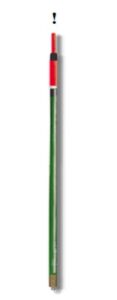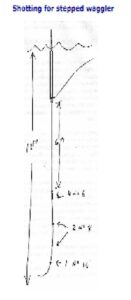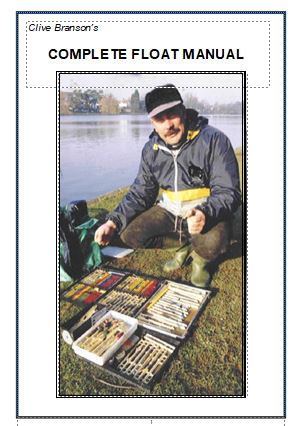🪶 Stepped Waggler

The Stepped Waggler is a natural progression from the inserted waggler.
It combines two key benefits in one float:
-
The ability to drag the bottom of the swim, slowing the bait’s movement for a natural presentation.
-
The sensitivity of a fine tip, allowing clear bite detection even at range.
This float is ideal for distance fishing and deeper swims where wind drift can otherwise affect presentation.
🏆 A Bit of History
This float is widely used by German and Austrian anglers on their large, open lakes, where precision and visibility are essential.
I was first introduced to the stepped waggler at the 1989 World Freshwater Angling Championships in Bulgaria by the Austrian national team. On Lake Plovdiv, a challenging venue with constant surface drift, these floats cast long distances and held position perfectly.
That year, the Welsh National Coarse Angling Team made history — becoming the first team to win the World Championship using wagglers. I also went on to win the second day with 28 lb of carp, roach, bream and vimba using this very method.
🏗️ Design and Construction
-
Material: Natural peacock quill
-
Body: Stepped design — a series of reducing-diameter peacock sections inserted into each other
-
Base: Loaded for longer casting and better stability
-
Tip: High-visibility stepped segments for changing light conditions
🎯 Benefits:
-
Carries extra shotting capacity for long-range work
-
Excellent visibility in difficult backdrops
-
Stable presentation in windy or drifting swims
-
Maintains tip sensitivity for clear bite indication
🌈 Colour and Visibility
The stepped sections are often painted in different colours (e.g. yellow, orange, white, or black).
This layered colouring allows the float to remain visible even as light and background conditions change throughout the day — a huge advantage on large venues.
🐟 Fishing Technique and Setup
-
Best suited for: Big lakes, reservoirs, or any open stillwater where long-range presentation is required.
-
Reel: Use an open-faced reel for smooth line release and longer casting.
-
Shotting: Heavy bulk plus droppers to balance the float and control the bait.
-
Line sinking:
-
After casting, dip the rod tip into the water and retrieve a few feet to sink the line.
-
This eliminates surface drift and creates a more direct connection to the float.
-
📝 Pro tip: Keep super glue and quick-drying fluorescent paint in your tackle box. They’re perfect for repairing minor float damage on the bank.
🎯 Casting Technique
Casting from the side requires a little practice but offers superb accuracy:
-
Hold the rod at waist level.
-
Grip the line just above the bait.
-
Allow the rod to load and bend.
-
Release smoothly — like a catapult action — for a long, clean cast.
✅ In summary:
-
A specialised waggler for long-range, sensitive fishing
-
Excellent in windy or drifting conditions
-
Proven on the world stage
-
A float every serious waggler angler should carry in their box
Illustration from the book

Now Available: The Complete Float Manual CLICK ON BOOK TO ORDER

📘 Download the Complete Float Manual – Instant Access
Bring decades of float-fishing knowledge straight to your screen.
Written by World Champion Clive Branson, The Complete Float Manual is a 167+ page eBook packed with practical techniques, classic float designs, diagrams, and championship-winning methods.
✅ Learn how to use wagglers, stick floats, pole floats and more
✅ Discover the history and evolution of float fishing
✅ Get pro tips and tactics used at the highest level
✅ Ideal for beginners and experienced match anglers alike
💻 Instant Download (PDF) — no waiting, no shipping
💳 Secure checkout with PayPal
👉 Order now and start reading within minutes.